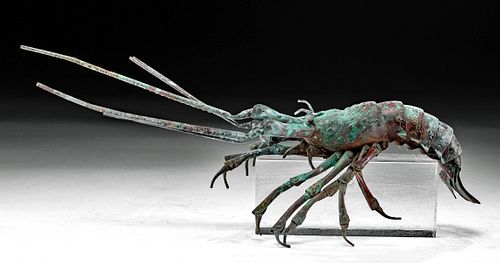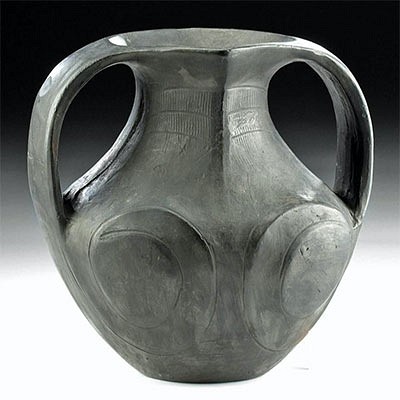Signed Japanese Edo Copper Articulated Crayfish
Lot 54c
About Seller
Artemis Fine Arts
686 S Taylor Ave, Ste 106
Louisville, CO 80027
United States
Selling antiquities, ancient and ethnographic art online since 1993, Artemis Gallery specializes in Classical Antiquities (Egyptian, Greek, Roman, Near Eastern), Asian, Pre-Columbian, African / Tribal / Oceanographic art. Our extensive inventory includes pottery, stone, metal, wood, glass and textil...Read more
Categories
Estimate:
$1,400 - $2,100
Absentee vs Live bid
Two ways to bid:
- Leave a max absentee bid and the platform will bid on your behalf up to your maximum bid during the live auction.
- Bid live during the auction and your bids will be submitted real-time to the auctioneer.
Bid Increments
| Price | Bid Increment |
|---|---|
| $0 | $25 |
| $300 | $50 |
| $1,000 | $100 |
| $2,000 | $250 |
| $5,000 | $500 |
| $10,000 | $1,000 |
| $20,000 | $2,500 |
| $50,000 | $5,000 |
| $100,000 | $10,000 |
| $200,000 | $20,000 |
About Auction
By Artemis Fine Arts
Dec 16, 2021
Set Reminder
2021-12-16 10:00:00
2021-12-16 10:00:00
America/New_York
Bidsquare
Bidsquare : VARIETY SALE | Antiquities & Ethnographic Art
https://www.bidsquare.com/auctions/artemis-gallery/variety-sale-antiquities-ethnographic-art-8026
Featuring classical antiquities, ancient and ethnographic art from cultures encompassing the globe. Egyptian, Greek, Roman, Etruscan, Near Eastern, Asian, Pre-Columbian, Native American, African / Tribal, Oceanic, Spanish Colonial, Russian, Fossils, Fine Art, more! Artemis Fine Arts info@artemisgallery.com
Featuring classical antiquities, ancient and ethnographic art from cultures encompassing the globe. Egyptian, Greek, Roman, Etruscan, Near Eastern, Asian, Pre-Columbian, Native American, African / Tribal, Oceanic, Spanish Colonial, Russian, Fossils, Fine Art, more! Artemis Fine Arts info@artemisgallery.com
- Lot Description
East Asia, Japan, late Edo to early Meiji Period, ca. mid-19th to early 20th century CE. A fine model of an articulated crayfish bearing an impressed signature on the underside of the carapace. Each hammered copper body component, leg, and antennae are riveted to its neighbor and articulates smoothly, with only the 5 tail fins being immobile. The surfaces of the crustacean are adorned with repousse nodules and incised striations, and soft green patina accentuates the red-brown copper surface. This type of sculpture - known as "jizai okimono," or lifelike, articulates animal figures - was first created by armor smiths during a peaceful period in the 17th century when samurai armor was not in such high demand. Size (including antennae and legs): 4.625" L x 2.375" W x 2.6" H (11.7 cm x 6 cm x 6.6 cm)
Cf. The British Museum, museum number 1937,1218.1
A jizai okimono lobster, signed Kozan (Tadase Kozan, 1869-1934) with a cursive monogram (kao) hammered for $37,500 at Christie's, New York "An Inquiring Mind: American Collecting of Japanese & Korean Art" auction (sale 13641, April 25, 2017, lot 68)
Provenance: private Chicago, Illinois, USA collection
All items legal to buy/sell under U.S. Statute covering cultural patrimony Code 2600, CHAPTER 14, and are guaranteed to be as described or your money back.
A Certificate of Authenticity will accompany all winning bids.
PLEASE NOTE: Due to recent increases of shipments being seized by Australian & German customs (even for items with pre-UNESCO provenance), we will no longer ship most antiquities and ancient Chinese art to Australia & Germany. For categories of items that are acceptable to ship to Australia or Germany, please contact us directly or work with your local customs brokerage firm.
Display stands not described as included/custom in the item description are for photography purposes only and will not be included with the item upon shipping.
#166772Back leg along proper right side reattached to body via copper-colored thread. Slight bending and indentations to some legs, antennae, and body sections, with light encrustations, and softening to some repousse and incised details. All body sections, legs, and antennae articulate smoothly. Great patina throughout. Impressed signature on bottom of carapace.Condition
- Shipping Info
-
All shipping is handled in-house for your convenience. Your invoice from Artemis Gallery will include shipping calculation instructions. If in doubt, please inquire BEFORE bidding for estimated shipping costs for individual items.
-
- Buyer's Premium



 EUR
EUR CAD
CAD AUD
AUD GBP
GBP MXN
MXN HKD
HKD CNY
CNY MYR
MYR SEK
SEK SGD
SGD CHF
CHF THB
THB













